22 Types of Chameleons Found Around The World
Chameleons have dwelled this world for some time now, the oldest of their fossils dating back 60 million years during the Paleocene period. Scientists have decided to call this first ever discovered species Anqingosaurus Brevicephalus. Since then, they have evolved into over 150 different types of chameleons that still exist in the world today.
With the oldest chameleon fossil ever found being 60 million years old, it is believed they evolved not long after the mass extinction that killed off most of the dinosaurs.
To our surprise, there are no native chameleons inhabiting South America or Australia. Instead, they’re found entirely in Africa, Asia, the Middle East, Madagascar, and Europe; the vast majority of which are found in Madagascar with Africa coming in second.
There are just two types of chameleons native to Europe, found in southern Spain and Portugal. There are 18 recognized species belonging to southern Africa, and there are over 100 types of chameleons native to Madagascar.
Thanks to us humans, there are also six species residing in Florida: The veiled chameleon, carpet chameleon, Malagasy giant chameleon, Jackson’s chameleon, Senegal chameleon, and the Meller’s chameleon.
Chameleons are known for three things:
One, they can change their color to either hide from predators or showcase their mood.
Two, they possess the ability to rotate their eyes at a complete 360 degrees to see every angle of their surroundings, much like owls use their necks.
And three, they have catapult-like tongues, like some species of frogs, to kill and eat their pray with. Their tongues have a sticky residue on them to keep insects from running or flying away, and chameleons have become quite successful using this method of hunting.
Meat makes up the entirety of a chameleons diet, as they feed mainly on crickets, grasshoppers, locusts, mantids, stick insects, worms and flies of many sorts, cicadas, snails, and some larger species even feed on small birds and other lizards.
Though most types of chameleons spend their lives in high canopy trees, some species spend most of their time residing in bushes, and every so often you’ll find a ground dweller.
Their reproduction methods are also different from the next, as some chameleons lay eggs, while others birth live young. As for the types of chameleons that birth live young, their babies will come out in a clear sack that sticks to tree branches, which they immediately climb out of once coming out of their mother.
Another way chameleons differ from one another is their size. Most chameleons are around 8 to 10 inches in length, though they range anywhere from the size of a dime to the size of a domesticated cat.
In the species that birth live young, the females are generally smaller than males. It is the opposite for the types of chameleons that lay eggs, as females will need the extra size to carry them inside of her.
So, let’s take a look at different types of chameleons from around the world:
1. Panther Chameleon

Panther chameleons are a favorite of many pet owners, as they’re one of the easier species to care for, and they’re also one of the most colorful and beautiful types of chameleons in the world. They live in trees and bushes of Madagascar in humid, moist climates, residing in the coastal lowlands of these areas.
- Scientific Name: Furcifer Pardalis
- Size: Males can reach 14-21 inches, females can reach 9-13 inches
- Range: Northern and coastal areas of Madagascar
2. Jackson’s Chameleon
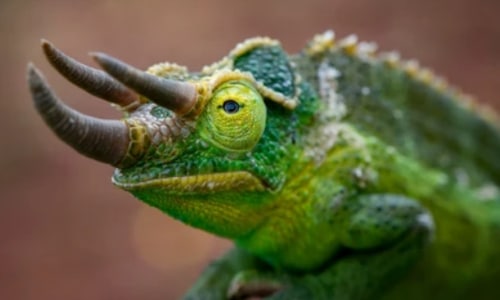
To many of our surprise, female Jackson’s chameleons never grow horns, and they’re also a tad smaller than males. As solitary creatures, Jackson’s chameleons spend most of their time in high canopy trees.
- Scientific Name: Trioceros Jacksonii
- Size: Males can reach 8-10 inches, females can reach 7-8 inches
- Range: Altitude woodlands and forests of of south-central Kenya and northern Tanzania
3. Veiled Chameleon

Veiled chameleons have a diversity of habitats they prefer, and can live either high up in trees, or lower to the ground in shrubs and bushes.
- Scientific Name: Chamaeleo Calyptratus
- Size: Males can reach up to 24 inches, though they average 14-18 inches, females can grow up to 10-12 inches
- Range: Near the border of Yemen and Saudi Arabia
4. Fischer’s Chameleon

This East African species is one of the larger types of chameleons that spends all of their time in trees, away from predators and close to pray.
- Scientific Name: Kinyongia Fischeri
- Size: Males can reach upwards of 15 inches, females reach between 8-10 inches
- Range: Nguru and Nguu Mountains of Tanzania
5. Common Chameleon

The common chameleon is the lone chameleon species on this list native to Europe. Isn’t it surprising there are chameleons in Europe but not South America or Australia?
- Scientific Name: Chamaeleonidae
- Size: Between 8-16 inches, females larger than males
- Range: Spain, Portugal, islands of the Mediterranean Sea, and the Near East
6. Meller’s Chameleon

Also one of the most beautiful types of chameleons in the world, Meller’s chameleons are found in bushland trees throughout the tropical grasslands of the areas listed below.
Meller’s chameleons are also one of the largest types of chameleons in the world, sometimes exceeding two feet in length.
- Scientific Name: Trioceros Melleri
- Size: Between 22-30 inches
- Range: Savanna, woodland and mountain regions of Malawi, Mozambique, and Tanzania
7. Chapman’s Pygmy Chameleon

The first ground dweller on this list goes to the Chapman’s pygmy chameleon. Though the particular chameleon pictured above is on a small branch, it was likely hunting down insects to eat near the forest floor.
- Scientific Name: Rhampholeon Chapmanorum
- Size: Up to 2.2 inches
- Range: Forests of Malawi Hill
8. Carpet Chameleon

These beautiful creatures live high up in trees in forests and woodland areas of Madagascar.
- Scientific Name: Furcifer Lateralis
- Size: Between 6-10 inches
- Range: Central-East Madagascar
9. Cape Dwarf Chameleon

As a smaller species of chameleon, cape dwarf’s, like Chapman’s pygmy’s, also inhabit the ground and low bushes of its climate, and also in Africa.
- Scientific Name: Bradypodion Pumilum
- Size: Between 1.7-4 inches
- Range: South Western Cape Region – Cape Town, De Hoop, Western Cape, South Africa
10. Indian Chameleon

Indian chameleons are an average sized species that live in trees of the areas listed below, and as you can see, they’re one of the more colorful types of chameleons in the world.
- Scientific Name: Chamaeleo Zeylanicus
- Size: Up to 7-8 inches
- Range: South of the Ganges River, South-Eastern Pakistan, and parts of Sri Lanka
11. Four Horned Chameleon

Ironically enough, four-horned chameleons can sport as few as one, or as many as six horns, and they generally live anywhere from 5-to-7 years in the wild.
- Scientific Name: Trioceros Quadricornis
- Size: Between 10-14 inches
- Range: Cameroon and eastern Nigeria
12. Calumma Chameleon
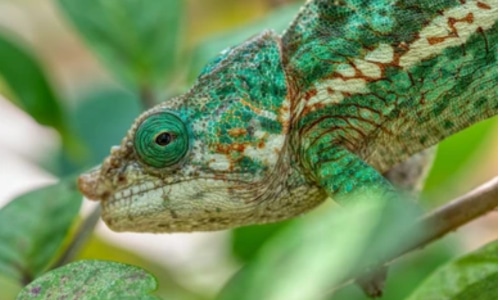
Calumma chameleons live in Madagascar rainforests at elevations of 600-to-1200 meters above sea level, and they inhabit trees anywhere from 4-to-40 feet in height.
- Scientific Name: Calumma
- Size: Between 5-6 inches
- Range: Madagascar
13. Oustalet’s Chameleon

Also known as the Malagasy Giant Chameleon, Oustalet’s chameleons are quite large in size, and prefer to live high up in trees in the arboreal forests of Madagascar.
- Scientific Name: Furcifer Oustaleti
- Size: Males up to 27 inches, females up to 12 inches
- Range: High and low elevations throughout Madagascar
14. Senegal Chameleon

Though the Senegal chameleon pictured above is a baby, these types of chameleons are an average size as adults. They live throughout many parts of Africa, and they can live up to five years in the wild.
However, females that reproduce may not live quite this long.
- Scientific Name: Chamaeleo Senegalensis
- Size: Between 7-8 inches, males typically smaller than females
- Range: Senegal, Mali, Nigeria, and Cameroon
15. Strange-Horned Chameleon
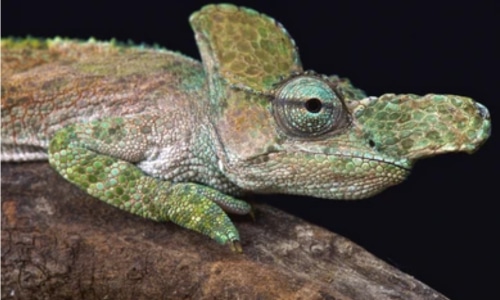
Like the aforementioned Senegal chameleon, strange-horned chameleons are also widely distributed through Africa, spending most of their lives, like most chameleons on this list, in trees.
- Scientific Name: Kinyongia Xenorhina
- Size: Up to 11 inches
- Range: Rainforests of the Ruwenzori Mountains of western Uganda and eastern Democratic Republic of the Congo
16. Labord’s Chameleon

Labord’s chameleons live the shortest life of any other on this list, reaching just four-to-five months in age before their time sadly runs out. As a result, they don’t grow too big.
- Scientific Name: Furcifer Labordi
- Size: Up to 1.1 inches
- Range: South western regions of Madagascar
17. Lesser Chameleon

Also known as the Minor’s chameleon, lesser chameleons are diurnal, meaning they’re active during the day, and they’re arboreal, meaning they live in trees. Just look at those patterns on this gorgeous lizard, they’re quite pleasant to observe.
- Scientific Name: Furcifer Minor
- Size: Males grow between 9-10 inches, females around 6 inches
- Range: Madagascar
18. Parsons Chameleon
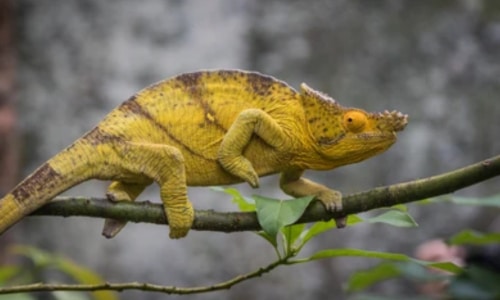
Widely considered the biggest chameleon in the world, the Parson’s chameleon often times measures over two feet in length. Being another arboreal species on this list, Parson’s chameleons rarely dwell the ground, and rather spend all of their lives in trees.
- Scientific Name: Calumma Parsonii
- Size: Up to 27-30 inches
- Range: Eastern and coastal Madagascar
19. Brookesia Chameleon
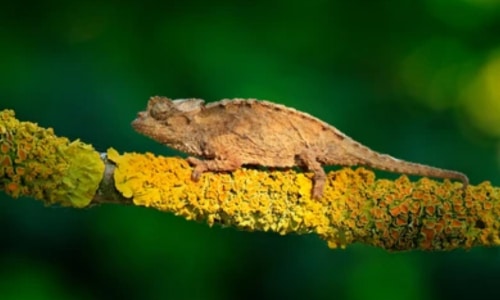
Just as we have the largest chameleon in the world listed at no. 18, our no. 19 spot goes to the smallest chameleon in the world, which doesn’t even measure one inch in length.
Brookesia chameleons also dwell the ground and forest floor, though they can occasionally be found on low-hanging branches.
- Scientific Name: Brookesia Nana
- Size: Between .6-.9 inches
- Range: Madagascar
20. Lance-Nosed Chameleon

One of the smaller types of chameleons in the world, lance-nosed chameleons are, like most species on this list, endemic to Madagascar.
- Scientific Name: Calumma Gallus
- Size: Between 4-5 inches
- Range: Eastern Madagascar
21. Two Horned Chameleon

Another incredibly beautiful species of chameleon, the two-horned chameleon, or Fischer’s two-horned chameleon, inhabits mountainous regions of Kenya and Tanzania.
- Scientific Name: Kinyongia Multituberculata
- Size: 9.5 inches for males, 7.5 inches for females
- Range: Afrotemperate forests of the West Usambara Mountains at elevation
22. Elephant Ear Chameleon

Also known as the short-horned chameleon, this species inhabits mid-altitude forests in humid regions of Madagascar. They are found in areas where agricultural trees are present, and can also be found in trees near buildings.
- Scientific Name: Calumma Bervicorne
- Size: Males up to 16 inches, females around 11 inches
- Range: Throughout Madagascar

I started writing in the fourth quarter of 2018. I wrote solely about MMA and boxing up until October of 2022, where I began writing about animals; primarily dangerous, venomous species. They’ve always fascinated me. Considering, my goal is to make a living by teaching people about these wonderful creatures. You can check out my Facebook page, where every article I’ve ever written currently sits, or you can check out my Twitter page, where I’ve shared all of my animal pieces to date.

